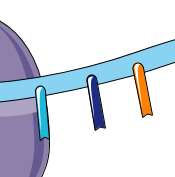Microfluidic qPCR
The high-throughput quantitative PCR platform is equipped with the Biomark-HD™ from Fluidigm.
The high-throughput quantitative PCR platform is equipped with Fluidigm’s Biomark-HD™, a system that allows the simultaneous quantification of the expression of tens of genes in a large number of samples in microfluidic chips.
Each chip consists of small volume reaction chambers (0.85nL, 6nL or 9nL) and an integrated fluidic circuit (IFC).
This set of interconnected microchannels allows the circulation of fluids (samples, mix and primers) and their distribution in reaction chambers, thus allowing a large number of quantitative PCR reactions to be parallelized in a small area.
Fluid circulation is ensured by IFC controllers, which, through pressure differences, cause the opening or closing of NanoFlexTM valves for the distribution and mixing of samples and primers. Fluorescence amplification and readout is provided by the Biomark-HD™ system itself.
The Biomark-HD™ platform is complemented by 3 types of IFC controllers (AX, HX and MX) suitable for 6 different chip formats:

Relative Quantification: 3 Dynamic Array™
FlexSix chip
- 6 independent partitions of 12.12
- 12 targets in 12 samples
- 9nL reaction chambers
- 144 to 864 PCR reactions
48.48 chip
- 48 targets in 48 samples
- 9nL reaction chambers
- 2304 PCR reactions
96.96 chip
- 96 targets in 96 samples
- 6nL reaction chambers
- 9216 PCR reactions
Sequencing library preparation: 1 Access Array ™
48.48 Access Array chip
-
From 48 to 4800 amplicons per sample
-
48 samples per run
Single cell genomics and trancriptomics
Chip to capture 96 individual cells according to their diameter
- Chip 5-10µm
- 10-17µm chip
- Chip 17-25µm
Absolute Quantification: 2 Digital Array™
12.765 chip
- 12 partitions of 765 chambers (12 samples)
- 6nL reaction chambers
- 9,180 PCR reactions
dPCR 37k chip
- 48 partitions of 770 chambers (48 samples)
- 0.85nL reaction chambers
- 36,960 PCR reactions
Expression variation by relative quantification: comparison of the expression level of target genes under different experimental conditions (control, test or pathological). Each target gene has its own fluorescence curve for each sample, from which the Cq value (quantification cycle) characteristic of the exponential phase of the amplification is extracted. The lower the Cq, the higher the initial amount of RNA (mRNA, miRNA, antisense RNA, circular RNA, converted to cDNA). The raw Cq values of the genes of interest are normalised with the Cqs of one or more reference genes, whose expression does not vary under the different experimental conditions and which have been chosen upstream by the project leader. The relative abundances of the target genes are determined by the following methods Livak (K.J. Livak et al. Methods 2001) or Pfaffl (M.W. Pfaffl Nucleic Acids Res. 2001), using R scripts developed by the platform.
Applied to genomic DNA, quantitative PCR can be used to analyse chromosomal anomalies (CNV), the presence of polymorphisms (SNP) and to genotype animal or cell lines.
Preparation of libraries for targeted sequencing: the Access Array chip allows the generation of PCR products ready for high-throughput sequencing. During PCR, labels (barcodes) specific to both the sequencing method (paired-end) and the sample are added to each amplicon, reducing the time required to enrich the target sequences before sequencing. This approach allows the generation of up to 4,800 amplicon libraries per sample, compatible with the chosen sequencer. By incorporating sample-specific barcodes, the PCR products from an IFC 48.48 Access Array are unique and can be pooled and analysed in a single sequencing experiment.
Single cell genomics and trancriptomics: The Fluidigm C1 system allows the capture of 96-800 single cells (depending on the array used) and preparation of genomic material for qPCR, RNAseq or DNAseq analysis.
Advantages of qPCR in microfluidics
- High throughput: from 144 to 9216 qPCR/chip or from 9180 to 36720 digital PCR/chip
- High intra- and inter-chip reproducibility (no need for technical replicates)
-
- CV intra-chip = 0.85%
- CV inter-chip = 1.92 %
-
- Reduced consumption of samples and reagents: reaction volumes in the order of a few nanolitres, i.e. 1000 times less than in conventional qPCR)
- Flexibility: the Biomark™ HD system is compatible with the chemistries commonly used in PCR (TaqMan®, EvaGreen®, UPL® Roche, Solaris®…)
- Suitable for all types of samples (small size, single cell etc.)
Microfluidic qPCR-HD nevertheless requires sample pre-amplification (STA: Specific Target Amplification, or WTA: Whole Transcriptome Amplification) due to the dilution effect of the chip.

















